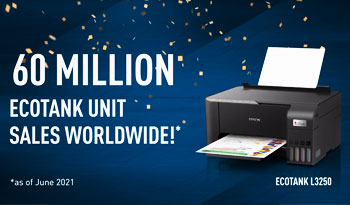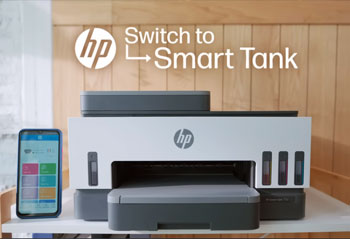Tired of constantly buying ink cartridges for your home printer? Ink tank printers like the Epson EcoTank and HP Smart Tank offer an affordable and efficient alternative by using bottled ink reservoirs. But how do you decide between these two major brands?
This comprehensive guide examines the key differences between EcoTank and Smart Tank printers. By understanding the pros, cons, and costs, you can determine which model fits your family’s printing needs.
A Brief Comparison Table
| Feature | Epson EcoTank | HP Smart Tank |
| Ink System | Bottle ink reservoirs | Bottle ink reservoirs |
| Print Quality | Up to 5760 dpi | Up to 4800 x 1200 dpi |
| Print Speed | Up to 15/8 ppm black/color | Up to 11/5 ppm black/color |
| Paper Capacity | Up to 250 sheets | Up to 225 sheets |
| Connectivity | Ethernet, WiFi, WiFi-Direct | WiFi, WiFi Direct |
| Price | $200-$500 | $150-$430 |
Overview of Epson EcoTank Printers
Epson’s EcoTank line of printers represents a pioneering leap in home printing technology. These innovative printers are designed with a revolutionary ink delivery system, replacing traditional cartridges with refillable ink tanks fed by bottled ink.
This transformative approach to printing offers several key features that make EcoTank printers stand out:

- High-Capacity Ink Tanks: EcoTank printers are equipped with refillable ink tanks that can hold a substantial amount of ink, enough to produce thousands of pages before needing a refill. This not only reduces the frequency of ink replacement but also minimizes the hassle of running out of ink at inconvenient times.
- Impressive Print Resolutions: Epson has not compromised on print quality. Many EcoTank models offer high-resolution printing capabilities, with some reaching resolutions of up to 5760 x 1440 dots per inch (dpi). This means that you can expect sharp and vibrant printouts, whether you’re producing text documents or high-quality photos.
- Efficient Printing Speeds: EcoTank printers are not just about quality; they’re also about speed. These printers can produce documents at a rate of up to 15 pages per minute (ppm) for black and white prints and up to 8 ppm for color prints. This makes them suitable for both everyday printing needs and more demanding tasks.
- Versatile Functionality: Epson has ensured that EcoTank printers are versatile machines. In addition to standard printing, they often come with scanning and copying capabilities, turning them into all-in-one devices. This versatility can save you space and money by eliminating the need for separate scanning and copying equipment.
- Connectivity Options: EcoTank printers offer a range of connectivity options to suit your needs. They can be connected to your network via Ethernet, providing a stable and high-speed connection. Additionally, they support WiFi connectivity, allowing for wireless printing from various devices. WiFi Direct functionality enhances convenience by enabling direct printing from mobile devices without the need for a network.
- User-Friendly Interface: EcoTank printers are designed with user convenience in mind. Many models feature LCD screens that facilitate navigation and settings adjustments. This user-friendly interface simplifies the printing process, making it accessible to users of all experience levels.
- Compact Design: Despite their impressive capabilities, EcoTank printers are designed with a compact footprint. This space-saving design ensures that the printer can fit comfortably in your home office or workspace, even if you have limited desk space.
One of the most compelling advantages of EcoTank printers is their cost-effectiveness over time. While the upfront investment may be higher compared to traditional cartridge-based printers, the substantial reduction in ink costs per page makes EcoTank printers an excellent choice for families or individuals who print frequently.
These printers are ideal for those who seek a balance between high-quality prints and long-term cost savings, making them a valuable addition to any home or office.
Also Read: Comparison Between the HP 7301 and Epson 4850
Overview of HP Smart Tank Printers
HP’s Smart Tank printers, introduced in 2018, marked the company’s entry into the ink tank printer market. These innovative printers are designed to compete with models like the EcoTank from Epson by offering a more affordable and efficient printing solution.
Much like their Epson counterparts, Smart Tank printers rely on refillable ink tanks instead of traditional cartridges. Below, we delve into the key features and advantages of HP’s Smart Tank printers:
- High-Capacity, Refillable Ink Tanks: Smart Tank printers are equipped with high-capacity ink tanks that can be refilled when needed. These tanks are designed to hold a significant amount of ink, allowing for a large volume of printing before requiring a refill. This not only reduces the frequency of ink replacement but also offers substantial cost savings over time.
- Impressive Print Quality: HP Smart Tank printers are capable of delivering excellent print quality with resolutions of up to 4800 x 1200 optimized dots per inch (dpi). Whether you’re printing text documents, graphics, or high-resolution photos, you can expect sharp and vibrant results.
- Efficient Printing Speeds: Smart Tank printers are designed for efficiency. They can produce documents at speeds of up to 11 pages per minute (ppm) for black and white prints and up to 5 ppm for color prints. These printing speeds make them suitable for a wide range of printing tasks, from everyday documents to photo printing.
- Dual-Band WiFi Connectivity: HP has equipped Smart Tank printers with dual-band WiFi connectivity. This feature ensures a stable and high-speed wireless connection to your network, making it easy to print from various devices, including smartphones and tablets.
- LED Display for Status: Many Smart Tank models come with LED displays that provide valuable status information. These displays make it easy to monitor ink levels, check the printer’s status, and perform maintenance tasks with ease.
- Compact Profile: HP has designed Smart Tank printers with a compact and space-saving profile. This compact design allows the printer to fit comfortably in small or tight spaces, making it an excellent choice for home offices and workspaces with limited room.
- Mess-Free Ink Refilling: HP takes pride in its ink tank design, which is touted as mess-free to refill. This user-friendly approach to refilling ink tanks minimizes the chances of spills or ink-related hassles, ensuring a hassle-free printing experience.
One of the primary advantages of Smart Tank printers is their affordability. While they may have a lower upfront cost compared to some other ink tank printers, they still offer significant cost savings over traditional cartridge-based printers in the long run.
This affordability, combined with impressive print quality and efficiency, makes Smart Tank printers an attractive option for those seeking reliable and economical printing solutions.
Also Read: Choose Between Formlabs And MakerBot.
Key Differences Between EcoTank and Smart Tank
With the basic pros and cons of each brand covered, here’s a deeper look at how they compare across several factors:
- Print Quality

Both EcoTank and Smart Tank printers deliver better-than-average print quality for home inkjet models. However, Epson EcoTank printers have a slight edge in maximum dpi resolution at 5760 x 1440 versus HP’s 4800 x 1200 optimized dpi. The extra dpi yields sharper clarity for photos and graphics. Text print quality is excellent on both though.
- Print Speed
Print speeds are fairly similar between EcoTank and Smart Tank models. Epson printers have a faster maximum black print speed of 15 ISO ppm versus 11 ISO ppm for HP. Color speeds are closer at 8 ISO ppm for Epson and 5 ISO ppm for HP. Overall EcoTank has the speed advantage but both will print quickly for most family needs.
- Ink Costs
The biggest benefit of ink tank printers is dramatically lower ink costs. EcoTank and Smart Tank both produce thousands of pages with each ink fill, while cartridges usually yield just a few hundred. Cost per page is a fraction compared to cartridge printers.
HP touts a lower cost per page at just $0.005 versus Epson’s $0.03. But in real life usage, both deliver exceptional economy and equivalent savings over traditional cartridges. Ink costs are low for both brands.
- Connectivity
EcoTank and Smart Tank printers come equipped with the standard connectivity options of WiFi and WiFi Direct for wireless printing from devices.
However, some EcoTank models add extra connectivity with ethernet slots for wired networks and routers. This provides more versatility, especially useful in office setups. The ethernet option gives Epson an advantage.
- Ease of Use
Both brands emphasize user-friendly operation, from intuitive control panels to easy maintenance. Epson EcoTanks have color LCD displays while HP Smart Tanks use LED indicators. HP touts mess-free refilling but in practice, Epson’s bottled ink system is only slightly messier. Both brands are quite easy to operate overall.
- Printer Size
EcoTank and Smart Tank printers share compact footprints that save valuable desktop space. The HP Smart Tank models have an edge here with smaller dimensions that can fit into the tightest home office nooks. But both brands work well for small spaces.
- Model Variety
Epson offers the greatest variety of EcoTank models from basic printers to all-in-one machines with scanning, copying and fax abilities. HP has a narrower range of just two Smart Tank standalone printers currently. Shoppers wanting an AIO have more flexibility with Epson.
- Price
The HP Smart Tank models are the most budget-friendly, ranging from $150-$250 MSRP. Epson EcoTank printers cost a bit more at $200-$500, but the price nets a larger feature set. HP is likely the better value for budget buyers focused on ink savings. But Epson gives more options.
Also Read: Comparison Between the Epson V550 and V600
Frequently Asked Questions (FAQs)
Epson EcoTank delivers superior print quality and speed, along with wider feature variety. But HP Smart Tank printers offer amazing value and efficiency. For home offices that print a lot, Epson EcoTank is likely the better choice if budget allows. HP can’t be beaten for affordability though.
HP uses the term Smart Tank while Epson calls their printers EcoTank, but both refer to the same technology of bottle-refillable ink tank systems. The terms are branding for comparable ink tank printer designs between the companies.
EcoTank is simply Epson’s brand name for their proprietary ink tank printers. It signifies key features like high-capacity ink tanks, affordable operation, and space-saving size. But functionally Epson EcoTank printers are the same technology as generic ink tank printers.
HP claims their Smart Tank printers can produce up to 8,000 color pages or 6,000 black pages with bundled ink sets. Real-world results depend on page coverage, but ink tanks yield several thousand pages at pennies per page before needing a refill.
Watch this review video:
Final Thoughts
Choosing between Epson EcoTank and HP Smart Tank models ultimately depends on your priorities. For best photo printing quality and speeds, Epson shines.
If cost is your top concern, HP delivers amazing efficiency at a budget price point. Home offices should consider the versatile Epson line, while light users might find HP’s basic printers sufficient.
Also Read: Comparison Between the Kodak Step and HP Sprocket
Whichever brand you select, you can’t go wrong with ink tank technology. Ditching expensive cartridges for cheap, high-capacity tanks revolutionizes home printing affordability. Just decide whether Epson or HP’s approach fits your family’s printing lifestyle and needs.

I have never seen the real reasons HP ink cannot be used in Epson printers and vice versa. Any idea who might have this explanation?